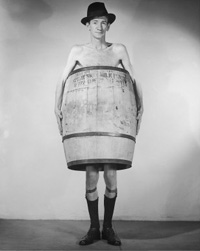 Irene Calboli has a new paper on SSRN entitled “A Critical Analysis of the Doctrine of Naked Licenses in Trademark Law.” A trademark owner may license others to produce and sell goods bearing his or her mark, but the owner must normally take steps to preserve control over the quality of the goods or the license may be regarded as “naked” and hence invalid. Irene’s paper reviews and critiques the development of this doctrine. She also proposes a new test for validity that focuses on the quality of the licensed goods instead of the degree of control exercised by the trademark owner.
Irene Calboli has a new paper on SSRN entitled “A Critical Analysis of the Doctrine of Naked Licenses in Trademark Law.” A trademark owner may license others to produce and sell goods bearing his or her mark, but the owner must normally take steps to preserve control over the quality of the goods or the license may be regarded as “naked” and hence invalid. Irene’s paper reviews and critiques the development of this doctrine. She also proposes a new test for validity that focuses on the quality of the licensed goods instead of the degree of control exercised by the trademark owner.
The paper was published as a chapter in volume three of Intellectual Property and Information Wealth: Issues and Practices in the Digital Age, edited by Peter K. Yu. The abstract appears after the jump.
Traditionally, the validity of trademark licensing has been based on the acceptance that, in addition to indicating the origin of the marked products, trademarks also guarantee their quality — that is, they guarantee that all the products bearing the same mark share the same quality. As long as a product’s quality is consistent and trademark owners have control over production and distribution, licensing has been permitted. Yet, if trademark owners fail to set sufficient quality standards and to exercise adequate control over their licenses, courts have often considered licenses “naked,” that is, invalid under the presumption that lack of control could lead to differences in product quality and, accordingly, consumer deception.
Courts elaborated this doctrine of naked licenses prior to the enactment of the Lanham Act of 1946 and have continued to follow it after its implementation. Since its inception, however, this doctrine has proved somewhat flawed, and courts have often applied it inconsistently. In particular, courts neither elaborated a specific test to assess what represents “sufficient control” nor clarified when licenses ought to be declared naked. Because of such uncertainty, several courts thus started to focus directly on the quality of the licensed products rather than on the actual control that trademark owners had over their licensors in the attempt to provide a more reasonable standard for the validity of licenses. Still, other courts have continued to interpret the doctrine conservatively and declared void licenses in the absence of actual control, thus leaving trademark owners and licensees with many doubts as to what represent a valid license. This Chapter criticizes this uncertainty and the current application of the doctrine of naked licenses, and advocates for a more consistent standard for the validity of trademark licensing. In particular, building upon the recent judicial trend, this Chapter suggests that courts should focus directly on the actual quality of the marked products. Accordingly, as long as this quality remains the same or, if changed for marketing or business reasons, consumers are not deceived, trademark licenses should be declared valid.
